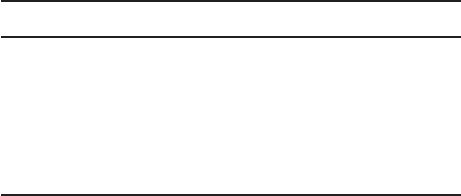Water and Wastewater Engineering
Подождите немного. Документ загружается.


23-88 WATER AND WASTEWATER ENGINEERING
S 0 as recommended by WEF (1998). Because a nitrogen balance cannot be computed
without P
x
, use the assumed NO
x
fraction, NO
x
0.80(TKN) 0.80(35) 28 mg/L as
a first approximation. Use the kinetic coefficients from Tables 23-13 and 23-14:
m
d
Y
k
60
040
.
.
g VSS/g VSS d
g VSS/gbCOD
0012. g VSS/g VSS d
P
x
()( )(22 500 0 40 220
3
,.m /d gVSS/gbCOD g/m
333
010
1012 9
)( )
[( )(
kg/g
g VSS/g VSS d.
..
..
54
015 012 2
d
g/g g VSS/g VSS d
)]
()( )(
22500 0 40 220 0
33
,.m /d gVSS/gbCOD g/m)( )( ) (()( )
[(
9 5410
1012
3
.
.
d kg/g
g VSS/g VSS
ddd
m /d gVSS/gNH
)( )]
()(
9 54
22 500 0 12
3
4
.
,.
--
.
Ng/m kg/g
gVSS/gVS
)( )( )
[(
28 10
1008
33
SSdd
)( )9 5 4
923 6158 53 42 87 1 124
.
.1..,P
x
.. 56 kg VSS/d
g. Determine the amount of NO
x
oxidized to nitrate using Equation 23-45.
NO g/m g/m
kg VSS/d
x
35 10 012
1 124 56
2
33
..
,.
22500
10
35 01060 28
3
3
,
...
m /d
g/kg
⎛
⎝
⎜
⎞
⎠
⎟
()
.. 0
3
g/m
h. Determine the mass of VSS and TSS in the aeration basin. With the exception of the
nbVSS, the mass has already been calculated in step (f). From the influent data, the mass
of nbVSS is 60 g/m
3
40 g/m
3
20 g/m
3
and the
Mass nbVSS
g/mm/d
()()
()( )(
Q
20 22 500 10
333
, kg/g kg/d) 450
The total mass of VSS is then
P
x,
,. ,.
VSS
kg/d kg/d or 11 124 564501574 56 ,,600 kg/d
The mass of MLVSS is equal to the MLVSS concentration times the volume of the aera-
tion tank, that is,
()()X
vss
.
V
This is equal to mass generated each day times the SRT,
that is, ( P
x, VSS
)(
c
).
Mass of MLVSS kg/dd()()1 124 569541072,. . ,88 3.kg
Using the assumed ratio of MLVSS to MLSS, the mass of MLSS may be estimated as
Mass of MLSS
kg
kg
10 728 3
08
13 410
,.
.
,
f
Y
d
n
015
012
4
.
.-
g/g
gVSS/gNH N

SECONDARY TREATMENT BY SUSPENDED GROWTH BIOLOGICAL PROCESSES 23-89
i. The concentration of MLSS times the volume of the aeration tank is equal to the m ass
of MLSS, that is,
()()X
MLSS
.
V
At the assumed MLSS of 3,000 g/m
3
, the volume of the
aeration tank may be estimated as follows:
()()
()
()
X
V
X
MLSS
MLSS
kg
kg
13 410
13 410
13
,
,
,,
,
,,
410
3 000 10
4 470 4
33
kg
g/m kg/g
or
()()
5500
3
m
V
V
j. Estimate the hydraulic detention time.
4,500 m
m /d
d or h
3
3
22 500
0 199 4 78
,
..
This is in the range of typical HRTs for the aerobic stage of BPR processes.
Comments:
1 . A volume of 4,500 m
3
i s too big to achieve complete mixing. A volume of about
3,000 m
3
i s about the maximum that should be used. For this example the flow should be
divided into eight parallel process lines.
2. Because a portion of the effluent from the aeration basin is recycled to the anoxic stage,
the basin may be segregated into two or more chambers with a reduced DO con
centra-
tion in the downstream chamber. This reduces the DO entering the anoxic tank.
Example 23-18. In continuing the design of the BPR process for Tempe’s new wastewater treat-
ment plant, determine the volume of the anoxic tank. Use the data provided in Example 23-17.
Solution:
a . This design is iterative. The effluent nitrate concentration is used to estimate the phos
-
phorus uptake in the anaerobic stage. If, in the next step of the design, the phosphorus
uptake is not adequate, the anoxic tank may have to be enlarged or chemical treatment
may be required.
b. Assume an effluent NO
3
-N concentration of 6.0 g/m
3
and determine the IR ratio using
Equation 23-54. From step (g) in Example 23-17 , NO
x
28.0 g/m
3
. From the assump-
tions in Example 23-17 , R 0.60.
IR
28 0
60
10 06 3 07
3
3
.
.
...
g/m
g/m

23-90 WATER AND WASTEWATER ENGINEERING
c. Determine the mass of NO
3
-N fed to the anoxic tank.
Flow rate to anoxic tank
( )() ()()IR Q R Q
3 0.7722500 0 60 22 500
82 575
33
()()(),.,
,
m /dm/d
mm/d
NO feedm/d g/m
x
3
33
82 575 60 495 4()(),. ,550g/d
d. Assume a detention time and estimate the volume of the anoxic tank. From Table 23-9
select an HRT of 1.0 h.
10
24
22 500 937 5 940
3
.
,.
h
h/d
m /d or
⎛
⎝
⎞
⎠
() m
3
V
e. Calculate the F / M using Equation 23-51. Note from Example 23-17 that
MLVSS 0.80(MLSS) and therefore MLVSS = (0.80)(3,000 g/m
3
) 2,400 g/m
3
.
F
M
()()
()(
22 500 138
940 2 400
33
3
,
,
m /d g/m
m g/
mm
g/g d
3
1 38
)
.
f. Determine the SDNR.
The fraction of rbCOD/bCOD
mg/L
mg/L
80
220
0036.
From Figure 23-12 , SDNR = 0.28 g/g · d
g. Determine the amount of NO
3
-N that can be reduced using Equation 23-52:
NO m g/g d g/m
r
()( )( )940 0 28 2 400
631
33
.,
,6680 g/d
From step (c), the NO
x
in the feed is 490,050 g/d. Therefore, there is about 30% excess
capacity.
Comments:
1 . The excess capacity for nitrate removal provides several options for the designer: one is
to consider it as a safety factor; another is to use a lower effluent concentration than the
assumed value of 6.0 g/m
3
; another is to rework the problem with an assumed HRT less
than 1.0 h.
2. There is an oxygen credit for the amount supplied by nitrate reduction that is not
accounted for in this example. See Equation 23-44 and the oxygen credit calculation in
Example 23-16.
3. The alkalinity check includes a credit for the alkalinity pro
duced in nitrate reduction.
This check is demonstrated in Example 23-19.

SECONDARY TREATMENT BY SUSPENDED GROWTH BIOLOGICAL PROCESSES 23-91
Example 23-19. Check the alkalinity for the BPR wastewater plant being designed for Tempe.
Use the d ata from Examples 23-17 and 23-18. Assume an alkalinity of 80 g/m
3
i s needed to
maintain a pH of about 7. The amount of nitrogen oxidized is NO
x
= 28.0 g/m
3
from step (g) in
Example 23-17.
Solution:
a . Prepare an alkalinity mass balance using the following equation:
Alkalinity to be added g/m influent alk80
3
aalinity alkalinity used
alkalinity produce
dd
(1) From Example 23-17 , the influent alkalinity 220 mg/L as CaCO
3
.
(2)
Alkalinity used gCaCO /gNH N NO
x
()()714
3 4
.-
()()7 14 28 0 199 92
3 4
3
.-..gCaCO /gNH N g/m gg/m
3
(3) Alkalinity produced (3.57 g CaCO
3
/g NO
3
-N)(28.0 g/m
3
6 g/m
3
) 78.54 g/m
3
b. Solving for “Alkalinity to be added”:
Alkalinity to be added g/m80 220 199 92 7
3
.88 541862
3
3
.. g/m as CaCO
The negative number implies that there is sufficient alkalinity in the influent wastewater.
Example 23-20. Estimate the effluent phosphorus concentration for Tempe’s new BPR waste-
water treatment plant. Use the data and assumptions from Examples 23-17 through 23-19. In
addition, assume the following:
• 10 g rbCOD/g P is removed by BPR
• rbCOD/nitrate ratio is 6.6 g rbCOD/g NO
3
-N
• Phosphorus content of heterotrophic bacteria is 0.015 g P/g biomass
• No NO
3
-N in influent
Solution:
a . Determine the rbCOD available for BPR using a mass balance at the influent to the
reactor.
()( )()( ) ( )(QQ QQ
RAS inf RAS RAS RAS
NO N NO N
33
--NNO N
React3
-)
where Q
RAS
0.60( Q ) from Example 23-17
(NO
3
-N)
RAS
6.0 g/m
3
from Example 23-18 at step (b)
(NO
3
-N)
React
nitrate feed to reactor

23-92 WATER AND WASTEWATER ENGINEERING
Substituting from assumptions:
06 06 60 16
3
3
3
... . -
-
QQg/m QNON
NO
React
()(())
(
NN
Q
Q
g/m gNO N/m
React
)()
06
16
60 225
3
3
3
.
.
..-
Using the assumption of 6.6 g rbCOD/g NO
3
-N:
rbCOD equivalent g NO N/m grb ()(225 66
3
3
.-.CCOD/g NO N g/m
3
3
14 85-.)
From the influent data given in Example 23-17 , the influent rbCOD is 80 g/m
3
. The
rbCOD available for BPR is
80 14 85 65 15
33 3
g/m g/m g/m..
b. Using the assumption that 10 g rbCOD/g P is removed by BPR, the estimated phospho-
rus removed by BPR mechanisms is
BPR removal
g rbCOD/m
grbCOD/gP
65 15
10
3
.
665265
3
..or g/m
c. Estimate the phosphorus used for heterotrophic biomass s ynthes is . Use Part A and Part
C from step (f) in Example 23-17.
P
x
923 42 87 966.16 . .0kg kg kg
Using the assumption that the phosphorus content of heterotrophic bacteria is 0.015 g
P/g biomass:
P used gP/gbiomass kg ()()(0015 966 10
3
..0gg/kg g/d) 14 490,
As a concentration, this is
14 490
22 500
064
3
3
,
,
.
g/d
m /d
g/m
d. Estimate the effluent soluble P:
Premoved g/m g/m g/m
Effl
6 52064716
333
...
uuent soluble P g/m g/m or 87160840
33
...88
3
g/m
This meets the effluent standard of 2 mg/L.
Comments:
1 . A large number of assumptions were used in estim ating the performance of the BPR
process. Prudent designers will evaluate the advisability of chemical addition to augment
the BPR.

SECONDARY TREATMENT BY SUSPENDED GROWTH BIOLOGICAL PROCESSES 23-93
2. The steps in this problem (Examples 23-17 through 23-20) were provided as an illustra-
tion of the computations that can be performed without simulation modeling. Prudent
design of this complex system requires the use of a simulation model to explore alternate
scenarios of flow, organic
composition, and loading.
Example 23-21. As part of a preliminary design, estimate the required blower power for the
complete-mix BOD removal and nitrification stage for Tempe’s new BPR wastewater treatment
plant ( Example 23-17 ). The following estimates have been provided for the design of one of eight
basins:
W a stewater depth 4.5 m
E q uivalent length of pipe 105
m
Air flow rate 90 m
3
/ min
A mbient air pressure 101.325 kPa 10.333 m of H
2
O 1 atmosphere
A mbient air temperature 47 C
Steel pipe diameter 350 mm
Diffuser losses 300 mm
Allowance for clogging 250 mm
Silencer 60 mm
Air filter 150 mm
Silencer 60 mm
S ubmergence 4,500 mm
Headloss in pipe ( h
L
) 55 mm
A ssume a blower efficiency of 70%.
Solution:
a . To size the blower, an estimate of the headloss for the steel delivery piping must be
made. This is an iterative solution because the headloss is a function of pressure, and the
headloss is used to determine the outlet pressure of the blower.
b. Use Equation 23-66 to estimate the friction factor.
f 0 029
0 350
90
0 027
3 0 148
.
.
.
.
()
()
m
m /min
⎛
⎝
⎜
⎞
⎠
⎟
0 029
097
195
0 0145.
.
.
.
⎛
⎝
⎞
⎠
c. From the range of rated discharge pressures, assume a trial pressure of 50 kPa. Convert
to “atmospheres” using the standard atmospheric pressure of 101.325 kPa.
50
101 325
049
kPa
kPa/atm
atm
.
.
This is gage pressure. Absolute pressure is 1 atm 0.49 atm 1.49 atm.
d. The temperature correction is estimated using Equation 23-65. The ambient temperature
of 47 C must be converted to kelvins:
T ()47 273
149
10
35823
0283.
.
.
.
atm
atm
K
⎛
⎝
⎞
⎠

23-94 WATER AND WASTEWATER ENGINEERING
e. Calculate the headloss using Equation 23-64.
h
L
982 10
0 0145 105 35823 90
8
3
.
..()()()(mm/m
iin
m
)
()( )
()
2
5
8
149 0350
982 10
442
..
.
.
⎛
⎝
⎜
⎞
⎠
⎟
10
783 10
55 44 55
6
3
.
.
⎛
⎝
⎜
⎞
⎠
⎟
= or mm of waterr
f. The total losses are estimated as follows:
S ubmergence 4,500 mm
Diffuser losses 300 mm
Allowance for clogging 250 mm
Silencer 60 mm
Air filter 150 mm
Headloss in pipe ( h
L
) 55 mm
Total headloss 5,315 mm of water
Converting to absolute pressure in atmospheres:
()()5 315 10
10 34
3
,
.
mm of water m/mm
m of wa
tter/atm
atm 0 514.
The absolute pressure is 1 atm 0.514 atm 1.514 atm. Note that this differs from the
assumed pressure of 1.49 atm used to compute the headloss. For a more refined analysis,
a second iteration using 1.514 atm would be used to calcu
late the headloss.
g. Size the blower based on an assumption that one blower serves two basins (2 90 m
3
/
min 180 m
3
/ min at standard temperature and pressure). At 1 atm pressure and 298 K
the density of air is 1.185 kg/m
3
. At the ambient temperature of 47 C, the density is esti-
mated to be
()1185
298
320
11035
33
..kg/m
K
K
kg/m
The mass flow rate of air is then
()( )180 . .m /min kg/m kg/min or
33
11035 198 65= kg/s331.
U sing Equation 23-63, the blower power is estimated to be:
P
w
() )()
(
3318314 320
29 7
..
.
kg/s kJ/k mol KK
00283 070
1 514
10
1
0283
..
.
.
.
)( )
atm
atm
⎛
⎝
⎞
⎠
⎡
⎣
⎢
⎤⎤
⎦
⎥
8 806 2
5 88
1125 1 187 20 190
,.
.
..[ ] or kW
Comments:
1 . A standard blower rated at or above 190 kW would be selected.

SECONDARY TREATMENT BY SUSPENDED GROWTH BIOLOGICAL PROCESSES 23-95
2. For the eight basins, four blowers plus a spare would be specified to meet redundancy
requirements.
3. This is a preliminary design. Given the number of assumptions made to arrive at losses,
iteration of the pressure assumption is not warranted.
4. The air piping network problem is similar to a water distribution network problem. Ty
pi-
cally, the solution will be obtained using a computer program.
23-8 MEMBRANE BIOREACTOR DESIGN PRACTICE
B e cause the membrane bioreactor (MBR) system can operate at a very high mixed liquor sus-
pended solids concentration, it has the following advantages over a conventional activated sludge
sys tem: (1) higher volumetric loading rates and shorter hydraulic detention times, (2) longer
sludge retention times
that result in less sludge production, (3) operation at low DO conc entra-
tions, (4) very high quality effluent in terms of suspended solids and BOD, (5) smaller footprint,
and (6) primary and secondary clarifiers are not required.
The disadvantages of the system are high capital costs, high replac
ement cost for membranes,
higher energy costs, and maintenance issues with respect to membrane fouling. Fine screens are
required.
Performance data indic ate that MBR processes can achieve effluent BOD and COD con-
centrations much less than 5 mg/L and 30 m g/L, re
spectively. Ammonia nitrogen levels less
than 1 mg/L and total nitrogen c oncentrations less than 10 mg/L have been achieved. Turbidity
values less than 1 NTU can be achieved by the membrane.
Although the situation is rapidly changing, the number of membrane installations is rela-
tively small and the length of experience with any given configu
ration is short. So far the experi-
ence has been excellent, but prudent engineering practice suggests that a thorough evaluation of
the state-of-the-art be conducted before commitment to a MBR technology is made.
The following discussion of design practice is drawn primarily from Metcalf & Eddy (2003)
and WEF (2006b).
Design Flow Rate
Unlike suspended growth processes that are process limited, MBRs have substantial hydraulic
limitations. Typically, MBRs are designed with a peaking factor of 2.0 to 2.5 (WEF, 2006b).
Redundancy
Membranes are mounted in subunits. They may be c alled arrays, racks, or cassettes. The sub-
units can be taken out of service individually without interrupting the process flow of the entire
line. A sufficient number of subunits should be provided so that the membrane system can hand
le
the peak flow with one cassette out of service.
Hint from the Field. Because of the high cost of membranes and their limited life as well as
their continued technological improvement and reduction in cost, the initial installation should be
provided with the number of subunits required to meet the initial flow rather than the final design
flow. However, facilities (bu
ilding space, tanks, and piping) to hold the subunits for the design
flow should be provided at the start of the design life.
23-96 WATER AND WASTEWATER ENGINEERING
Equalization
S ufficient tankage should be provided to equalize flows in excess of the design peaking factor.
This may be either in-line or off-line storage.
Preliminary Treatment
Removal of grit and materials that can be screened is critical for the operation and maintenance
of the membrane. Each membrane manufacturer has specific screening requirements. In practice,
most new facilities are being designed with screens with openings smaller than 2 mm, and a trend
toward 1
mm screens has been observed (WEF, 2006b). The best protection for membranes is to
use the finest screen possible while minimizing the potential for bypass around the screen. The
screen should be at the head end of the plant.
Primary Treatment
Primary clarifiers are not specifically required for a MBR. Fine screens will remove 15 to 25 percent
of the BOD (WEF, 1998). If further reduction is required to improve the efficiency of the activated
sludge system or to reduce the total energy required for aeration, a primary settling tank may be
employed.
Solids Retention Time (SRT)
Most of the initial MBR systems were designed with SRTs on the order of 30 to 70 days. Recent
experience with immersed membranes indicates that biopolymer fouling is not strongly related to
SRT provided that the SRT is at least long enough to perform nitrification. It is anticipated that
the selection of an SRT will now be governed by the objective of the process and
, in the case of
nitrification, the temperature of the wastewater.
Mixed Liquor Suspended Solids (MLSS)
I mmersed MBR systems have been operated with MLSS concentrations ranging from 8,000 to
18,000 mg/L. However, the very high MLSS concentrations reduce membrane flux and the aera-
tion alpha factor. This leads to higher energy requirements. Current design practice is to use
MLSS concentrations in the range of 8,000 to 10,000 mg/L.
Dissolved Oxygen
T ypical DO concentrations in various zones of an MBR are (WEF, 2006b):
• Anoxic: 0.0 to 0.5 mg/L
• Aerobic: 1.5 to 3.0 mg/L
• Membrane: 2.0 to 6.0 mg/L
O xygen transfer efficiency may be adversely affected by the high MLSS concentration in the
reactor because of the reduced alpha factor.

SECONDARY TREATMENT BY SUSPENDED GROWTH BIOLOGICAL PROCESSES 23-97
Return Activated Sludge (RAS)
RAS rates of 400 percent of the influent flow rate are not uncommon.
Hint from the Field. A mixed flow return sludge pump with a large turn down ratio is
recommended.
Sludge Wasting
A s in the suspended growth processes, the SRT requirements of the biological process determine
the amount of sludge that must be wasted. Typical wasting points are from the return sludge
line, the drain line from the membrane tanks, and the surface of the bioreactor. Wasting from the
return sludge line provides the highes
t MLSS concentration.
Pumps
There are a number of special pumps associated with the membrane system that are not common
to typical suspended growth processes. In particular, there are pumps for permeate and back-
pulse. Typically the permeate pump is a rotary-lobe pump because it can handle a large percent
of entrained air. The bac
k-pulse pump is only used in MBR systems that use hollow-fiber mem-
branes. Typically these pumps are centrifugal pumps.
Design Criteria
Table 23-21 provides a summary of the range of MBR design values.
Fouling
Theoretical concepts of membrane fouling are presented in Chapter 12. The fouling of mem-
branes in MBR reactors results in similar pressure cycles as those shown in Figure 12-4. This
results from biomass coating of the outer layers of the membrane and penetration of finer particles
to the inner pores of the membrane. Additionally, som
e chemical precipitation on the surfaces
may occur. To maintain the performance of the membrane, two types of cleaning are performed:
maintenance cleaning and recovery cleaning.
TABLE 23-21
Range of MBR design values
Parameter Range of values
Flux 25–46 L/m
2
· h
Transmembrane pressure (TMP) 7 to 65 kPa
SRT 5–20 d
MLSS 8,000–10,000 mg/L
MLVSS 6,000–8,000 mg/L
HRT 4–6 h
Sources: Metcalf & Eddy, 2003; WEF, 2006b.
